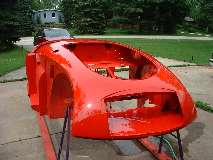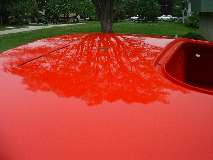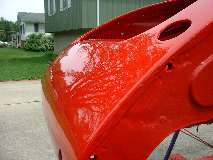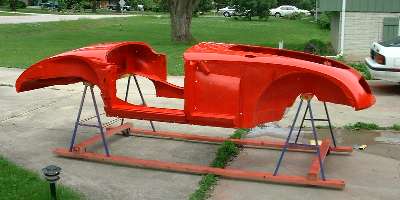


 The MGA With An Attitude
The MGA With An Attitude
Body Sill Replacement - RT-631
Final Wet Sanding and Paint Buffing
Next morning I couldn't wait to roll it out into the sunlight, and OH MY GOODNESS !!! I couldn't resist posting slightly larger format pictures for this. The paint was damn nice for an untouched fresh spray job.



My first reaction was to maybe skip the final wet sanding and go right to buffing. But I knew there was some dirt in the surface that wouldn't go away with just buffing, and I was curious to see what it could look like without the slight orange peel finish, so sand away.
This final wet sanding turned out to be somewhat more work than I had in mind. I wanted to finish with 2000 grit before buffing, and I thought it might be easy enough to remove the orange peel with the 2000 grit paper, like we did with the club project car last summer. Then I also remember how many people worked on that all day, didn't get it done, and ultimately buffed it up with some texture still left. After rubbing on the front cowling for an hour with 2000 grit and not being half way finished, I decided it needed coarser paper to get the whole car done in days rather than weeks. I switched to 1500 grit to finish the front cowling, then do the back cowling, but it was still a lot of work. By the time I went over it again with 2000 grit I had shot half the day and only had the main body shell top cowling finished. These were not particularly large surfaces, and there were NINE pieces left to do.
I did the doors next figuring they are small and simple panels, dropped them on saw horses and started with 1500 grit. Bright sunlight helps a lot when you need to see the surface texture difference between flat and slight orange peel. It all looks perfect when it's wet, even before sanding. In years past I had used a tracer coat, just a very light mist of contrasting gray primer, to highlight the texture. One aerosol can might be enough to cover the whole car if you don't over do it. When you sand off the tops of the bumps (orange peel) you get red freckles in the gray field. More sanding makes larger freckles until the freckles run into each other and you get gray spider web in the red field. With continued sanding the spider web finally disappears, and then you stop sanding, knowing it is flat without removing too much paint.
Well, no tracer coat this time. With warm temperature, low humidity, bright sunlight and a nice breeze, I just rinse well and wipe the panel and set it aside occasionally to dry while I do sanding on a different panel. When the panel is dry it is easy to see what isn't flat yet, as little pock marks or scratches stand out like evil scars in a surrounding flat field. While alternating on the doors I would occasionally go back for a little touch up on the main body, and oh yes, I forgot I still had to do the rocker panels. When I was sure it was all flat I switched to 2000 grit for a final once over to finish. By the time I got all this done the bright sun was dropping behind some trees and it was getting harder to see the final results, so I set it aside nearly two hours before sunset. .... (11 June 08)
I gotta tell you, this is nothing like the 6-hour 600-grit wet sanding in between paint coats. Even 1500 grit wet paper is slow. When I ran into a particularly tough spot I might switch to 1000 grit for a while in a small area to work out the "roughies", then go back to 1500 grit, and finally finish a final pass with 2000 grit. I certainly had no worries about sanding through the paint, as long as I was careful not to sand on panel edges. To make a long story short (at least not so long), I was only working on this about 5 hours a day for a few more days. On Friday the 13th (wouldn't you know) I had just started a little buffing to see how it might work when my "new" 2 month old sander/buffer crapped out, apparently a faulty speed control module. It would have to ship to California for warrantee coverage, and I wasn't waiting for this one, so I ran out to Harbor Freight and bought another one, and then it was dark again.
Saturday morning I had another test run with the buffer on the main body cowling. I am using 3M Perfect-It (tm) 3000 buffing products, very nice stuff. There are several grades of this goop, and I only have two. The first is Extra Cut Rubbing Compound 06060. When I finally read the label again it says "Effectively removes grade P1200 and finer sanding scratches", and it does too. The first time I touched it on the 2000 grit sanded surface with the power buffer the sanding marks simply vanished in about three seconds. So why did I spend all that time sanding down to 2000 grit surface finish? Call it a touch of senility, as I'm sure I read this when I bought the product and simply forgot. Luckily I figured this out Friday evening as soon as I had bought the replacement buffer. I then put the 2000 grit paper back in the cabinet and finished the rest of the wet sanding with 1000 followed by 1500 grit. That must have saved a full day of wet sanding and could have saved another day if I had caught on earlier. I finally had all the wet sanding done on Saturday, so all the paint was dull again, except for the main body which was finish buffed. Oh yes, the second grade of buffing compound I use is the other 3M Perfect-It 3000 product, Ultrafina (tm) SE 06068. A little dab goes a long way here, as it wipes out the swirl marks from the Extra Cut in a flash. I spent more time washing the panels and looking at the reflections than I did buffing with the Ultrafina. There are one or two grades of buffing compound finer than this, but I can't imagine why anyone would need it (well, maybe the show car enthusiasts). .... (14 June 08)
I took a day away from the project on Sunday (surprise), ran off to a club tech session to help install Speedy Sleeves on another MGA, followed by a barbeque and a little natter. It was a nice way to spend a warm and sunny Father's Day.

 I got back to work on the paint on Monday, spending about 4 hours buffing before running off to the monthly MG club meeting in the evening. On Tuesday I finished buffing the front fenders and valance panel, then washed up and put the power buffer and goop away. It might come out again for a touch up after the body is all assembled. .... (17 June 08)
I got back to work on the paint on Monday, spending about 4 hours buffing before running off to the monthly MG club meeting in the evening. On Tuesday I finished buffing the front fenders and valance panel, then washed up and put the power buffer and goop away. It might come out again for a touch up after the body is all assembled. .... (17 June 08)
|